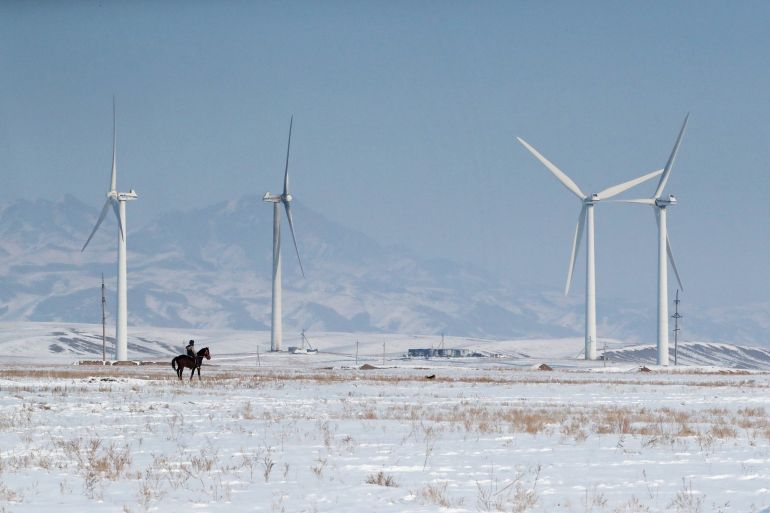Clean energy surges globally, but has yet to replace fossil fuels: Report
Clean sources accounted for more than 40 percent of electricity production last year for the first time.

By John T PsaropoulosPublished On 8 Apr 20258 Apr 2025
The world produced more than 40 percent of its electricity from clean energy sources for the first time since World War II last year, a new report from a global energy think tank says.
Staggering growth in solar generation has led the charge, doubling every three years since 2012, Ember said in its report on Tuesday.
Recommended Stories
list of 4 items
Africa must shun Trump’s push to resurrect coal
end of list
Together with nuclear power, hydroelectricity and growing wind power, low-emissions electricity generation has now reached 40.9 percent.
“Solar power has become the engine of the global energy transition,” said Phil MacDonald, managing director of Ember, based in London. “As the fastest-growing and largest source of new electricity, it is critical in meeting the world’s ever-increasing demand for electricity.”
But clean electricity is barely managing to keep abreast of soaring new demand, meaning it is not yet cutting into fossil fuels’ share of the electricity market to reduce greenhouse gas emissions.
Ember believed that was poised to happen last year.
Its 2024 Global Electricity Review predicted fossil fuels’ share in electricity generation was going to drop by 2 percent in 2024, and that would mark the beginning of a decades-long decline.
Advertisement
Last year’s record global temperatures and heatwaves upset that calculation, because demand for cooling raised electricity consumption by 4 percent.
That meant fossil energy sources also grew by 245 terawatt-hours (TWh), but not nearly as much as renewables, which grew by a record 927TWh, depriving fossil fuels of most of their growth potential.
Ember insists that renewables and other clean energy sources will eventually top rising demand from higher temperatures and other electricity demand pressures such as data centres, artificial intelligence and electric vehicles.
“While demand growth is undoubtedly going to be higher than in previous years, Ember’s analysis shows that clean growth is set to outpace it, making long-term investments to grow fossil [energy] generation a risky bet,” the report said.
When that will happen is not clear.
The answer matters, because the International Energy Agency (IEA), an intergovernmental body and energy think tank, estimated in 2023 that to keep the global temperature increase to 1.5C (2.7F) by 2100, fossil fuel use has to fall by 25 percent by 2030 and 80 percent by 2050.
That, in turn, meant that global investment in renewables “needs to climb to around $4.5 trillion a year by the early 2030s to be in line with our pathway”, the IEA said in its Pathway to Net Zero report in 2023. At the time, the world was at just below half that goal. All new investment in fossil fuel extraction, transport and refinement would also have to be eliminated, the IEA said. Neither of these things has yet happened.
Advertisement
“There’s clearly a trend for clean energy sources to increase their share. I’m not sure when or if they would replace fossil fuels, which remain a part of the global energy mix,” Costis Stambolis, executive director of the Institute of Energy for Southeast Europe, an Athens-based think tank, told Al Jazeera.
“The fact that [renewables] are increasing doesn’t necessarily mean they will replace fossil fuels … It depends on a complex set of energy relationships,” Stambolis said.
He pointed out that a key factor in renewable energy absorption was investment in energy grids.
“You can’t electrify the economy if renewable energy is being thrown out of a system that can’t absorb renewable energy,” he said.
China versus the US
Ember’s report outlined a clear divergence between the world’s two largest economies, the United States and China.
“China registered more than half of the global increase in both solar and wind power in 2024 and is the world leader in both clean energy manufacturing and deployment,” the report said.
The US was China’s mirror image in gas. It was the world’s largest producer of electricity from gas last year, accounting for half of all global growth in gas-fired electricity production
At 1,865TWh, US electricity from gas was more than three times larger than Russia’s, which remained in second place at 538TWh.
Across the European Union, gas-fired electricity generation was down by 26TWh, falling for the fifth year in a row.
Ember’s findings largely dovetail with those of the IEA, which this year found that renewables are now responsible for a record 38 percent of all energy consumption, including electricity, transport and heating.
Advertisement
For the world to contain global warming to 1.5C, the IEA has said, installed renewable power capacity must triple by 2030, energy efficiency must double each year, energy sector methane emissions must fall by 75 percent and sales of electric cars and heat pumps must rise sharply.
